Chemical properties of iron as a transition metal
VerifiedAdded on 2022/09/08
|7
|1447
|8
AI Summary
Contribute Materials
Your contribution can guide someone’s learning journey. Share your
documents today.
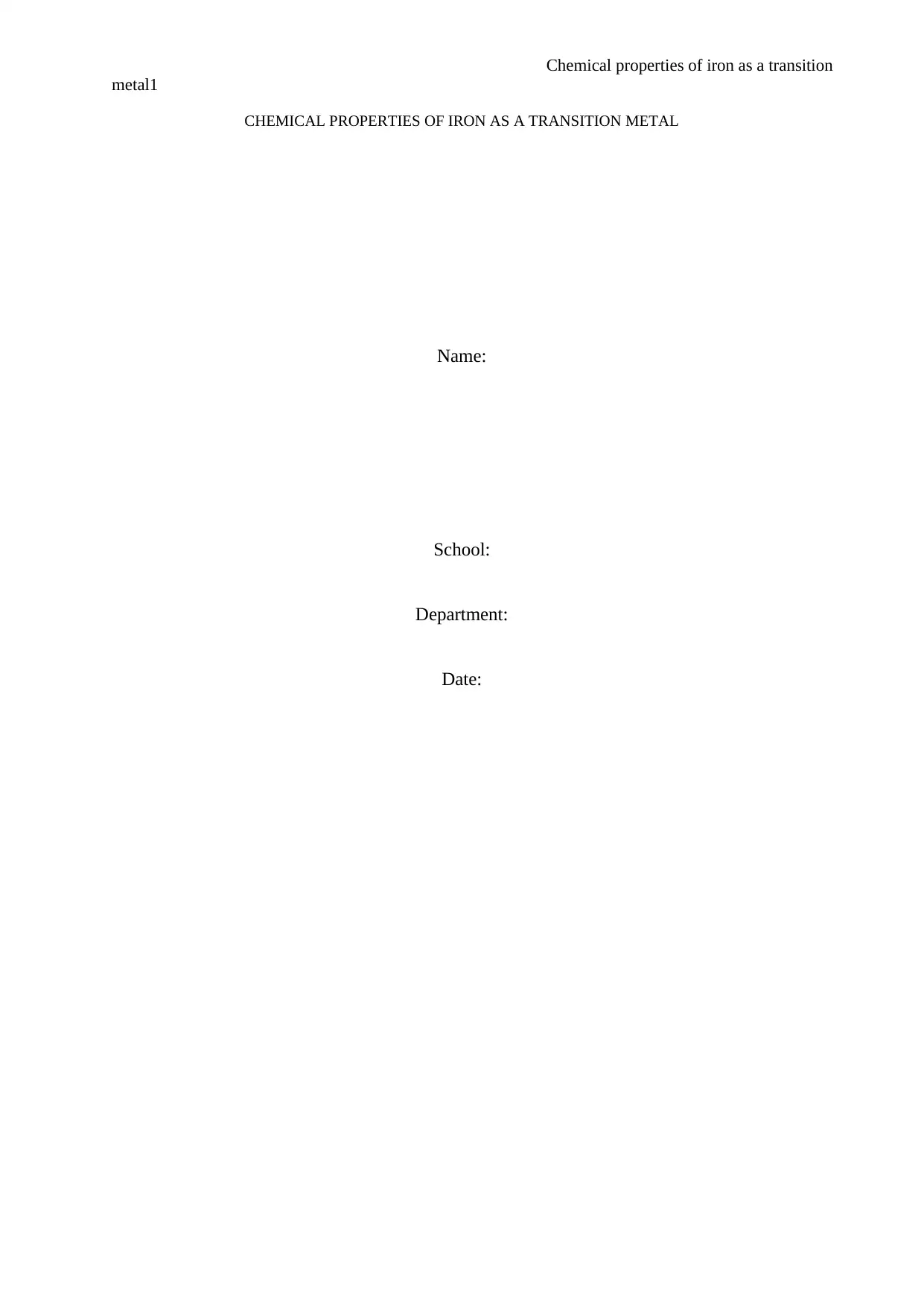
Chemical properties of iron as a transition
metal1
CHEMICAL PROPERTIES OF IRON AS A TRANSITION METAL
Name:
School:
Department:
Date:
metal1
CHEMICAL PROPERTIES OF IRON AS A TRANSITION METAL
Name:
School:
Department:
Date:
Secure Best Marks with AI Grader
Need help grading? Try our AI Grader for instant feedback on your assignments.
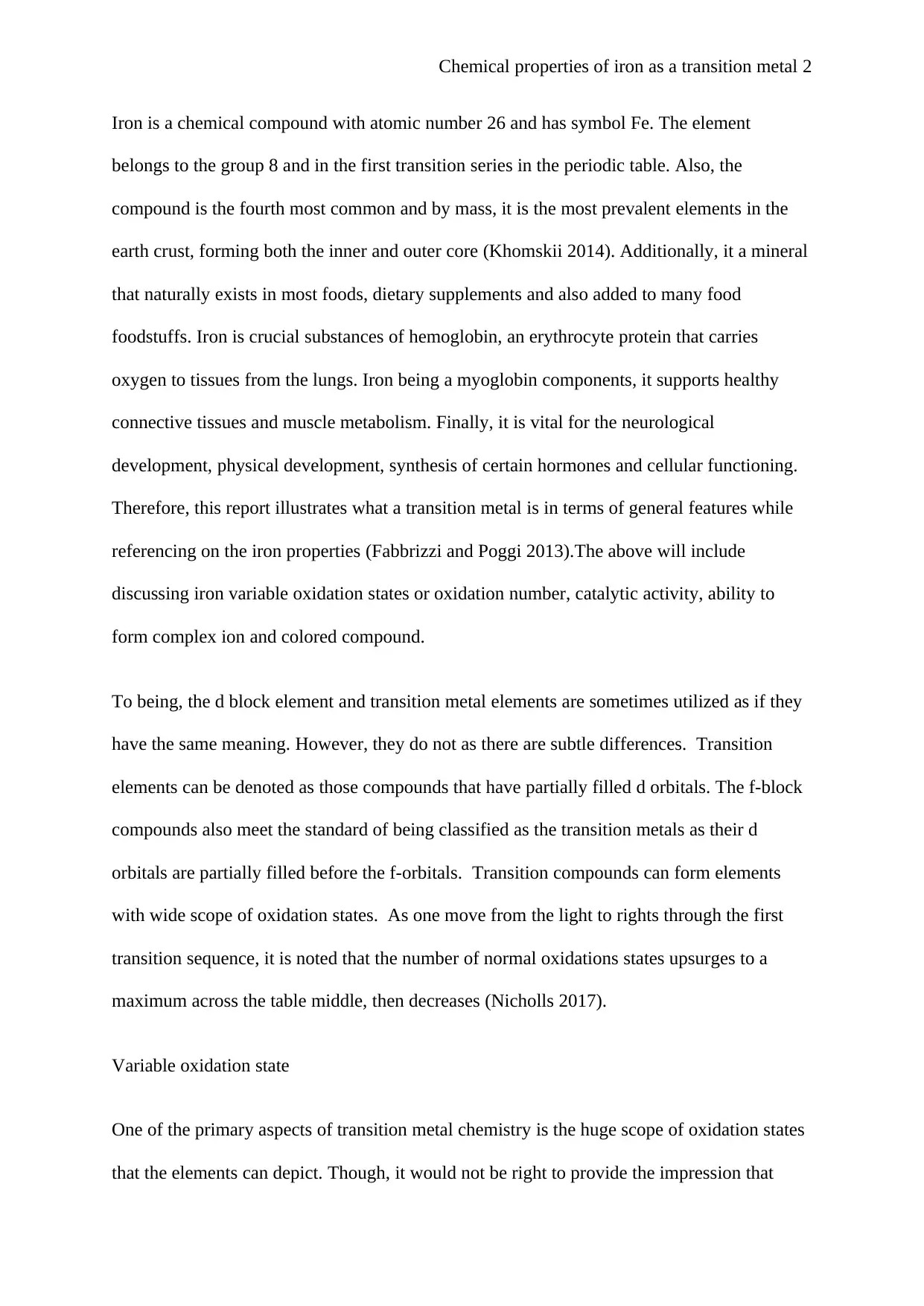
Chemical properties of iron as a transition metal 2
Iron is a chemical compound with atomic number 26 and has symbol Fe. The element
belongs to the group 8 and in the first transition series in the periodic table. Also, the
compound is the fourth most common and by mass, it is the most prevalent elements in the
earth crust, forming both the inner and outer core (Khomskii 2014). Additionally, it a mineral
that naturally exists in most foods, dietary supplements and also added to many food
foodstuffs. Iron is crucial substances of hemoglobin, an erythrocyte protein that carries
oxygen to tissues from the lungs. Iron being a myoglobin components, it supports healthy
connective tissues and muscle metabolism. Finally, it is vital for the neurological
development, physical development, synthesis of certain hormones and cellular functioning.
Therefore, this report illustrates what a transition metal is in terms of general features while
referencing on the iron properties (Fabbrizzi and Poggi 2013).The above will include
discussing iron variable oxidation states or oxidation number, catalytic activity, ability to
form complex ion and colored compound.
To being, the d block element and transition metal elements are sometimes utilized as if they
have the same meaning. However, they do not as there are subtle differences. Transition
elements can be denoted as those compounds that have partially filled d orbitals. The f-block
compounds also meet the standard of being classified as the transition metals as their d
orbitals are partially filled before the f-orbitals. Transition compounds can form elements
with wide scope of oxidation states. As one move from the light to rights through the first
transition sequence, it is noted that the number of normal oxidations states upsurges to a
maximum across the table middle, then decreases (Nicholls 2017).
Variable oxidation state
One of the primary aspects of transition metal chemistry is the huge scope of oxidation states
that the elements can depict. Though, it would not be right to provide the impression that
Iron is a chemical compound with atomic number 26 and has symbol Fe. The element
belongs to the group 8 and in the first transition series in the periodic table. Also, the
compound is the fourth most common and by mass, it is the most prevalent elements in the
earth crust, forming both the inner and outer core (Khomskii 2014). Additionally, it a mineral
that naturally exists in most foods, dietary supplements and also added to many food
foodstuffs. Iron is crucial substances of hemoglobin, an erythrocyte protein that carries
oxygen to tissues from the lungs. Iron being a myoglobin components, it supports healthy
connective tissues and muscle metabolism. Finally, it is vital for the neurological
development, physical development, synthesis of certain hormones and cellular functioning.
Therefore, this report illustrates what a transition metal is in terms of general features while
referencing on the iron properties (Fabbrizzi and Poggi 2013).The above will include
discussing iron variable oxidation states or oxidation number, catalytic activity, ability to
form complex ion and colored compound.
To being, the d block element and transition metal elements are sometimes utilized as if they
have the same meaning. However, they do not as there are subtle differences. Transition
elements can be denoted as those compounds that have partially filled d orbitals. The f-block
compounds also meet the standard of being classified as the transition metals as their d
orbitals are partially filled before the f-orbitals. Transition compounds can form elements
with wide scope of oxidation states. As one move from the light to rights through the first
transition sequence, it is noted that the number of normal oxidations states upsurges to a
maximum across the table middle, then decreases (Nicholls 2017).
Variable oxidation state
One of the primary aspects of transition metal chemistry is the huge scope of oxidation states
that the elements can depict. Though, it would not be right to provide the impression that
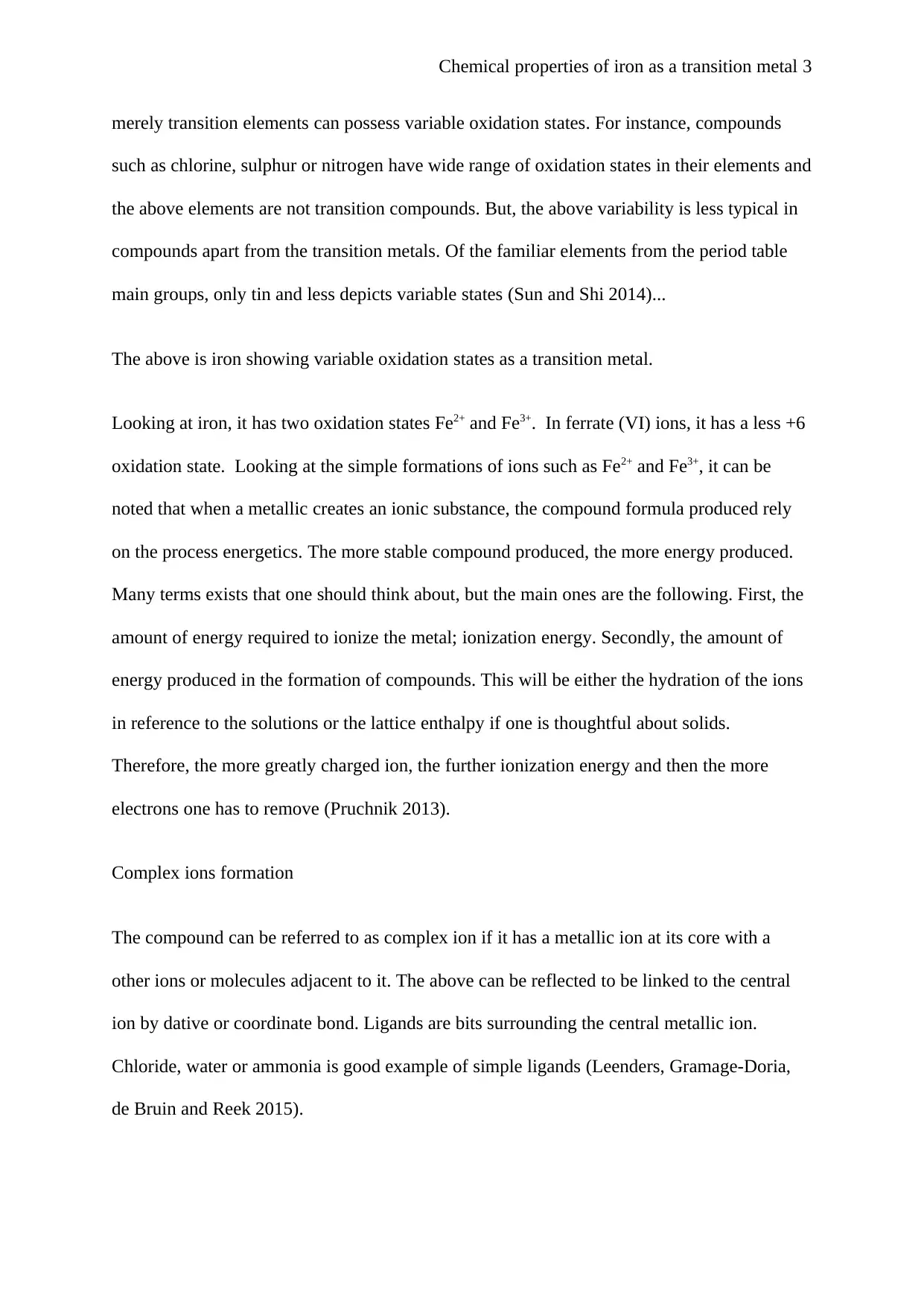
Chemical properties of iron as a transition metal 3
merely transition elements can possess variable oxidation states. For instance, compounds
such as chlorine, sulphur or nitrogen have wide range of oxidation states in their elements and
the above elements are not transition compounds. But, the above variability is less typical in
compounds apart from the transition metals. Of the familiar elements from the period table
main groups, only tin and less depicts variable states (Sun and Shi 2014)...
The above is iron showing variable oxidation states as a transition metal.
Looking at iron, it has two oxidation states Fe2+ and Fe3+. In ferrate (VI) ions, it has a less +6
oxidation state. Looking at the simple formations of ions such as Fe2+ and Fe3+, it can be
noted that when a metallic creates an ionic substance, the compound formula produced rely
on the process energetics. The more stable compound produced, the more energy produced.
Many terms exists that one should think about, but the main ones are the following. First, the
amount of energy required to ionize the metal; ionization energy. Secondly, the amount of
energy produced in the formation of compounds. This will be either the hydration of the ions
in reference to the solutions or the lattice enthalpy if one is thoughtful about solids.
Therefore, the more greatly charged ion, the further ionization energy and then the more
electrons one has to remove (Pruchnik 2013).
Complex ions formation
The compound can be referred to as complex ion if it has a metallic ion at its core with a
other ions or molecules adjacent to it. The above can be reflected to be linked to the central
ion by dative or coordinate bond. Ligands are bits surrounding the central metallic ion.
Chloride, water or ammonia is good example of simple ligands (Leenders, Gramage-Doria,
de Bruin and Reek 2015).
merely transition elements can possess variable oxidation states. For instance, compounds
such as chlorine, sulphur or nitrogen have wide range of oxidation states in their elements and
the above elements are not transition compounds. But, the above variability is less typical in
compounds apart from the transition metals. Of the familiar elements from the period table
main groups, only tin and less depicts variable states (Sun and Shi 2014)...
The above is iron showing variable oxidation states as a transition metal.
Looking at iron, it has two oxidation states Fe2+ and Fe3+. In ferrate (VI) ions, it has a less +6
oxidation state. Looking at the simple formations of ions such as Fe2+ and Fe3+, it can be
noted that when a metallic creates an ionic substance, the compound formula produced rely
on the process energetics. The more stable compound produced, the more energy produced.
Many terms exists that one should think about, but the main ones are the following. First, the
amount of energy required to ionize the metal; ionization energy. Secondly, the amount of
energy produced in the formation of compounds. This will be either the hydration of the ions
in reference to the solutions or the lattice enthalpy if one is thoughtful about solids.
Therefore, the more greatly charged ion, the further ionization energy and then the more
electrons one has to remove (Pruchnik 2013).
Complex ions formation
The compound can be referred to as complex ion if it has a metallic ion at its core with a
other ions or molecules adjacent to it. The above can be reflected to be linked to the central
ion by dative or coordinate bond. Ligands are bits surrounding the central metallic ion.
Chloride, water or ammonia is good example of simple ligands (Leenders, Gramage-Doria,
de Bruin and Reek 2015).
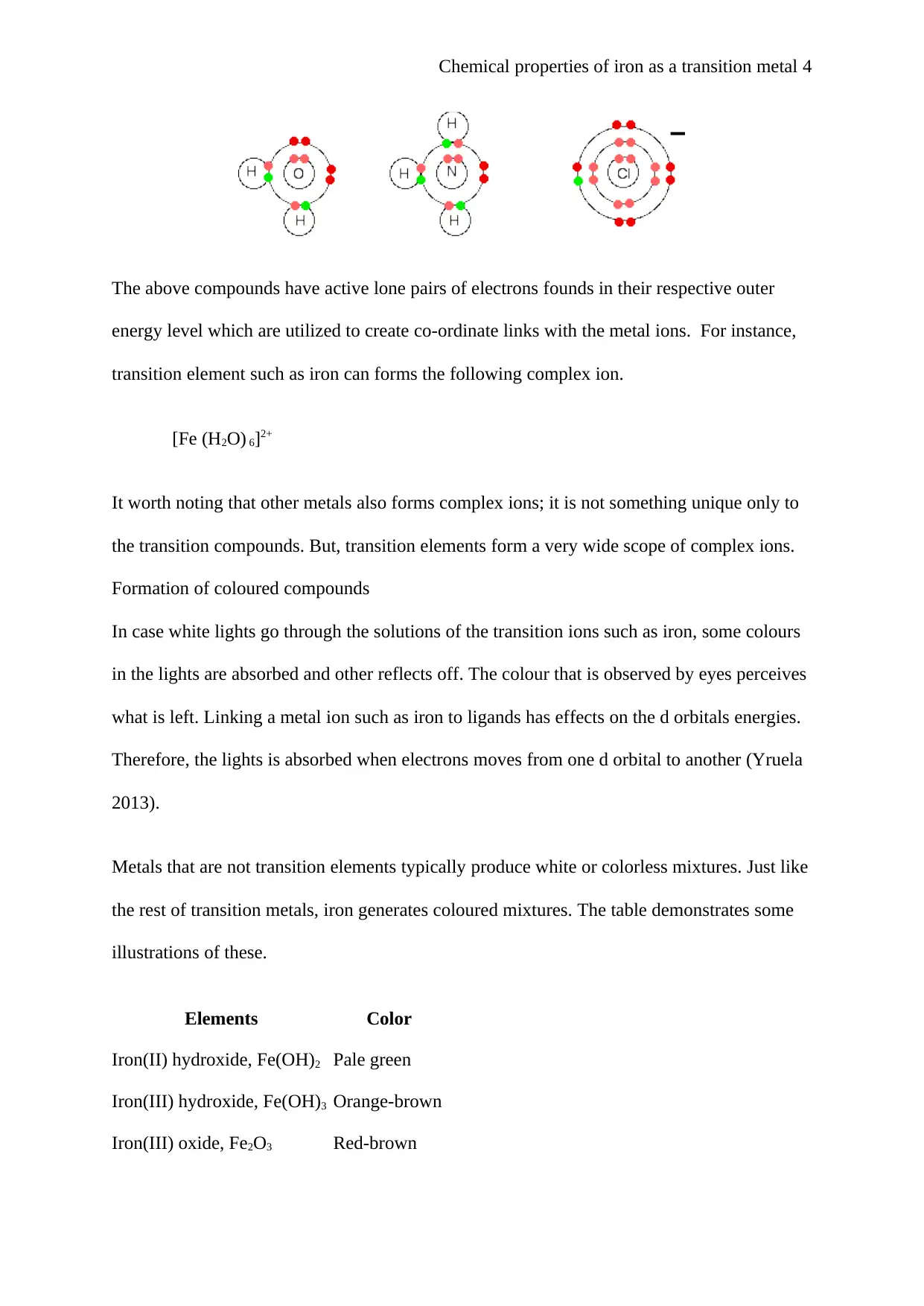
Chemical properties of iron as a transition metal 4
The above compounds have active lone pairs of electrons founds in their respective outer
energy level which are utilized to create co-ordinate links with the metal ions. For instance,
transition element such as iron can forms the following complex ion.
[Fe (H2O) 6]2+
It worth noting that other metals also forms complex ions; it is not something unique only to
the transition compounds. But, transition elements form a very wide scope of complex ions.
Formation of coloured compounds
In case white lights go through the solutions of the transition ions such as iron, some colours
in the lights are absorbed and other reflects off. The colour that is observed by eyes perceives
what is left. Linking a metal ion such as iron to ligands has effects on the d orbitals energies.
Therefore, the lights is absorbed when electrons moves from one d orbital to another (Yruela
2013).
Metals that are not transition elements typically produce white or colorless mixtures. Just like
the rest of transition metals, iron generates coloured mixtures. The table demonstrates some
illustrations of these.
Elements Color
Iron(II) hydroxide, Fe(OH)2 Pale green
Iron(III) hydroxide, Fe(OH)3 Orange-brown
Iron(III) oxide, Fe2O3 Red-brown
The above compounds have active lone pairs of electrons founds in their respective outer
energy level which are utilized to create co-ordinate links with the metal ions. For instance,
transition element such as iron can forms the following complex ion.
[Fe (H2O) 6]2+
It worth noting that other metals also forms complex ions; it is not something unique only to
the transition compounds. But, transition elements form a very wide scope of complex ions.
Formation of coloured compounds
In case white lights go through the solutions of the transition ions such as iron, some colours
in the lights are absorbed and other reflects off. The colour that is observed by eyes perceives
what is left. Linking a metal ion such as iron to ligands has effects on the d orbitals energies.
Therefore, the lights is absorbed when electrons moves from one d orbital to another (Yruela
2013).
Metals that are not transition elements typically produce white or colorless mixtures. Just like
the rest of transition metals, iron generates coloured mixtures. The table demonstrates some
illustrations of these.
Elements Color
Iron(II) hydroxide, Fe(OH)2 Pale green
Iron(III) hydroxide, Fe(OH)3 Orange-brown
Iron(III) oxide, Fe2O3 Red-brown
Secure Best Marks with AI Grader
Need help grading? Try our AI Grader for instant feedback on your assignments.
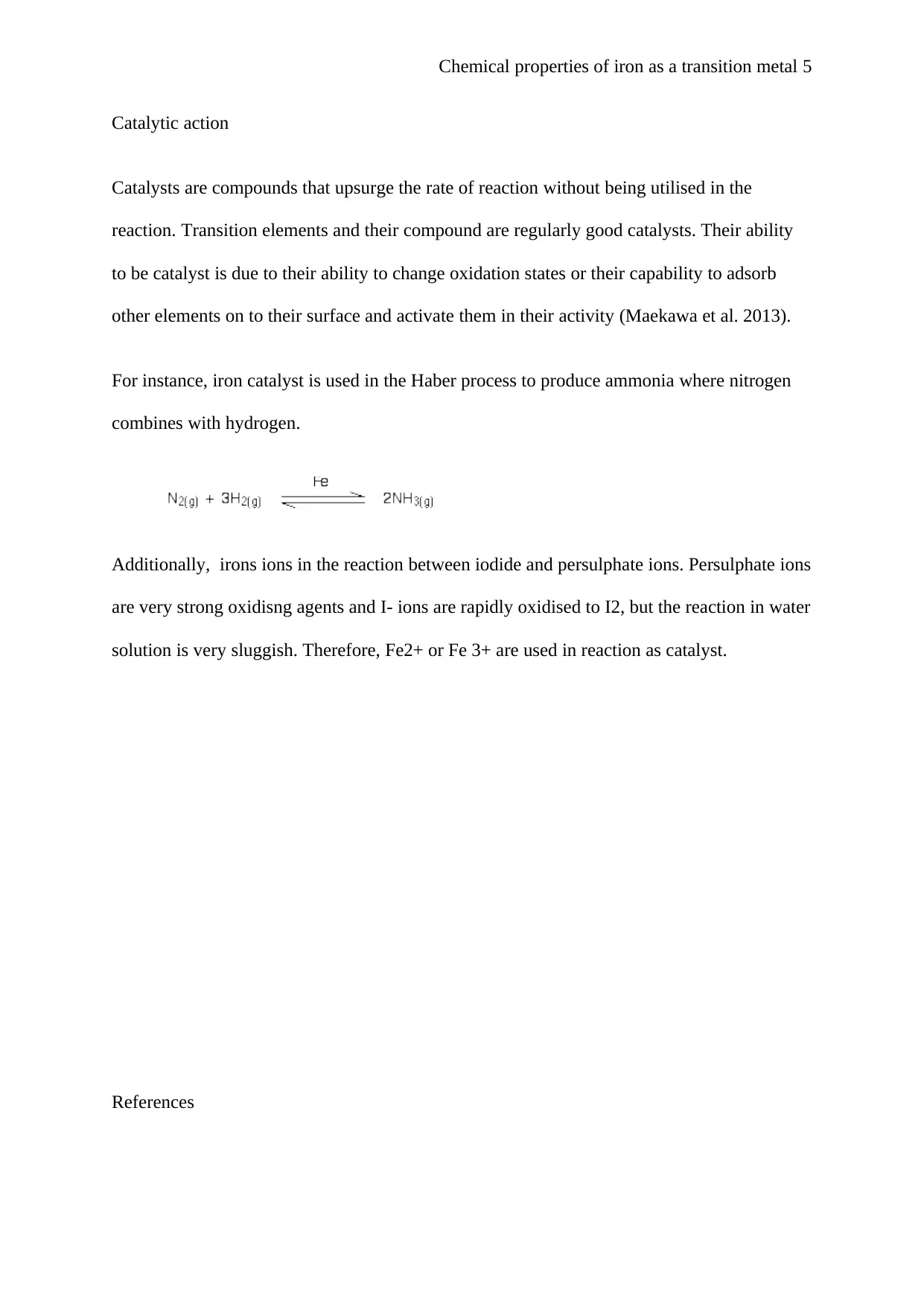
Chemical properties of iron as a transition metal 5
Catalytic action
Catalysts are compounds that upsurge the rate of reaction without being utilised in the
reaction. Transition elements and their compound are regularly good catalysts. Their ability
to be catalyst is due to their ability to change oxidation states or their capability to adsorb
other elements on to their surface and activate them in their activity (Maekawa et al. 2013).
For instance, iron catalyst is used in the Haber process to produce ammonia where nitrogen
combines with hydrogen.
Additionally, irons ions in the reaction between iodide and persulphate ions. Persulphate ions
are very strong oxidisng agents and I- ions are rapidly oxidised to I2, but the reaction in water
solution is very sluggish. Therefore, Fe2+ or Fe 3+ are used in reaction as catalyst.
References
Catalytic action
Catalysts are compounds that upsurge the rate of reaction without being utilised in the
reaction. Transition elements and their compound are regularly good catalysts. Their ability
to be catalyst is due to their ability to change oxidation states or their capability to adsorb
other elements on to their surface and activate them in their activity (Maekawa et al. 2013).
For instance, iron catalyst is used in the Haber process to produce ammonia where nitrogen
combines with hydrogen.
Additionally, irons ions in the reaction between iodide and persulphate ions. Persulphate ions
are very strong oxidisng agents and I- ions are rapidly oxidised to I2, but the reaction in water
solution is very sluggish. Therefore, Fe2+ or Fe 3+ are used in reaction as catalyst.
References
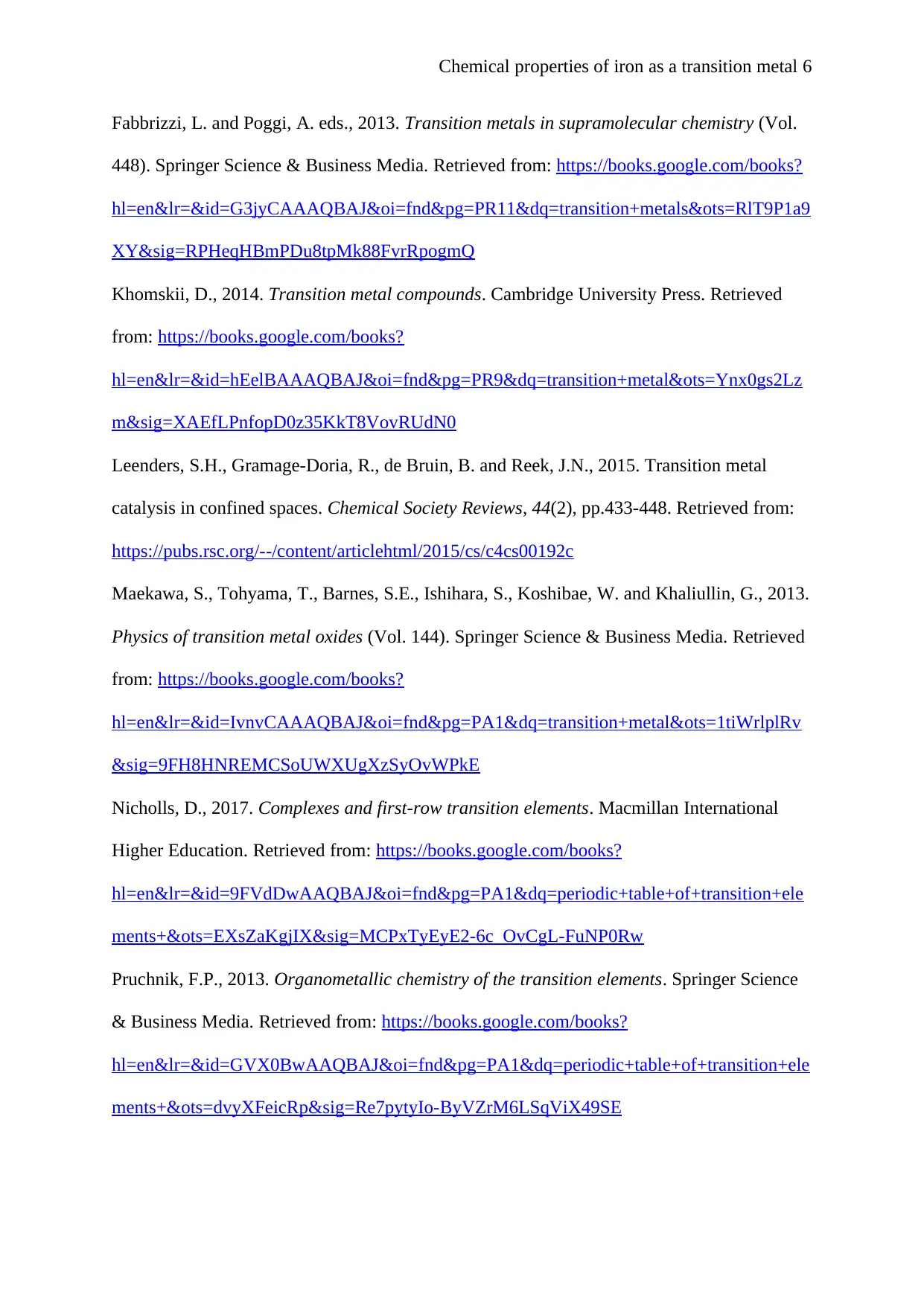
Chemical properties of iron as a transition metal 6
Fabbrizzi, L. and Poggi, A. eds., 2013. Transition metals in supramolecular chemistry (Vol.
448). Springer Science & Business Media. Retrieved from: https://books.google.com/books?
hl=en&lr=&id=G3jyCAAAQBAJ&oi=fnd&pg=PR11&dq=transition+metals&ots=RlT9P1a9
XY&sig=RPHeqHBmPDu8tpMk88FvrRpogmQ
Khomskii, D., 2014. Transition metal compounds. Cambridge University Press. Retrieved
from: https://books.google.com/books?
hl=en&lr=&id=hEelBAAAQBAJ&oi=fnd&pg=PR9&dq=transition+metal&ots=Ynx0gs2Lz
m&sig=XAEfLPnfopD0z35KkT8VovRUdN0
Leenders, S.H., Gramage-Doria, R., de Bruin, B. and Reek, J.N., 2015. Transition metal
catalysis in confined spaces. Chemical Society Reviews, 44(2), pp.433-448. Retrieved from:
https://pubs.rsc.org/--/content/articlehtml/2015/cs/c4cs00192c
Maekawa, S., Tohyama, T., Barnes, S.E., Ishihara, S., Koshibae, W. and Khaliullin, G., 2013.
Physics of transition metal oxides (Vol. 144). Springer Science & Business Media. Retrieved
from: https://books.google.com/books?
hl=en&lr=&id=IvnvCAAAQBAJ&oi=fnd&pg=PA1&dq=transition+metal&ots=1tiWrlplRv
&sig=9FH8HNREMCSoUWXUgXzSyOvWPkE
Nicholls, D., 2017. Complexes and first-row transition elements. Macmillan International
Higher Education. Retrieved from: https://books.google.com/books?
hl=en&lr=&id=9FVdDwAAQBAJ&oi=fnd&pg=PA1&dq=periodic+table+of+transition+ele
ments+&ots=EXsZaKgjIX&sig=MCPxTyEyE2-6c_OvCgL-FuNP0Rw
Pruchnik, F.P., 2013. Organometallic chemistry of the transition elements. Springer Science
& Business Media. Retrieved from: https://books.google.com/books?
hl=en&lr=&id=GVX0BwAAQBAJ&oi=fnd&pg=PA1&dq=periodic+table+of+transition+ele
ments+&ots=dvyXFeicRp&sig=Re7pytyIo-ByVZrM6LSqViX49SE
Fabbrizzi, L. and Poggi, A. eds., 2013. Transition metals in supramolecular chemistry (Vol.
448). Springer Science & Business Media. Retrieved from: https://books.google.com/books?
hl=en&lr=&id=G3jyCAAAQBAJ&oi=fnd&pg=PR11&dq=transition+metals&ots=RlT9P1a9
XY&sig=RPHeqHBmPDu8tpMk88FvrRpogmQ
Khomskii, D., 2014. Transition metal compounds. Cambridge University Press. Retrieved
from: https://books.google.com/books?
hl=en&lr=&id=hEelBAAAQBAJ&oi=fnd&pg=PR9&dq=transition+metal&ots=Ynx0gs2Lz
m&sig=XAEfLPnfopD0z35KkT8VovRUdN0
Leenders, S.H., Gramage-Doria, R., de Bruin, B. and Reek, J.N., 2015. Transition metal
catalysis in confined spaces. Chemical Society Reviews, 44(2), pp.433-448. Retrieved from:
https://pubs.rsc.org/--/content/articlehtml/2015/cs/c4cs00192c
Maekawa, S., Tohyama, T., Barnes, S.E., Ishihara, S., Koshibae, W. and Khaliullin, G., 2013.
Physics of transition metal oxides (Vol. 144). Springer Science & Business Media. Retrieved
from: https://books.google.com/books?
hl=en&lr=&id=IvnvCAAAQBAJ&oi=fnd&pg=PA1&dq=transition+metal&ots=1tiWrlplRv
&sig=9FH8HNREMCSoUWXUgXzSyOvWPkE
Nicholls, D., 2017. Complexes and first-row transition elements. Macmillan International
Higher Education. Retrieved from: https://books.google.com/books?
hl=en&lr=&id=9FVdDwAAQBAJ&oi=fnd&pg=PA1&dq=periodic+table+of+transition+ele
ments+&ots=EXsZaKgjIX&sig=MCPxTyEyE2-6c_OvCgL-FuNP0Rw
Pruchnik, F.P., 2013. Organometallic chemistry of the transition elements. Springer Science
& Business Media. Retrieved from: https://books.google.com/books?
hl=en&lr=&id=GVX0BwAAQBAJ&oi=fnd&pg=PA1&dq=periodic+table+of+transition+ele
ments+&ots=dvyXFeicRp&sig=Re7pytyIo-ByVZrM6LSqViX49SE

Chemical properties of iron as a transition metal 7
Sun, C.L. and Shi, Z.J., 2014. Transition-metal-free coupling reactions. Chemical reviews,
114(18), pp.9219-9280. Retrieved from: https://pubs.acs.org/doi/full/10.1021/cr400274j
Yruela, I., 2013. Transition metals in plant photosynthesis. Metallomics, 5(9), pp.1090-1109.
Retrieved from: https://pubs.rsc.org/en/content/articlehtml/2013/mt/c3mt00086a
Sun, C.L. and Shi, Z.J., 2014. Transition-metal-free coupling reactions. Chemical reviews,
114(18), pp.9219-9280. Retrieved from: https://pubs.acs.org/doi/full/10.1021/cr400274j
Yruela, I., 2013. Transition metals in plant photosynthesis. Metallomics, 5(9), pp.1090-1109.
Retrieved from: https://pubs.rsc.org/en/content/articlehtml/2013/mt/c3mt00086a
1 out of 7
Your All-in-One AI-Powered Toolkit for Academic Success.
+13062052269
info@desklib.com
Available 24*7 on WhatsApp / Email
![[object Object]](/_next/static/media/star-bottom.7253800d.svg)
Unlock your academic potential
© 2024 | Zucol Services PVT LTD | All rights reserved.

